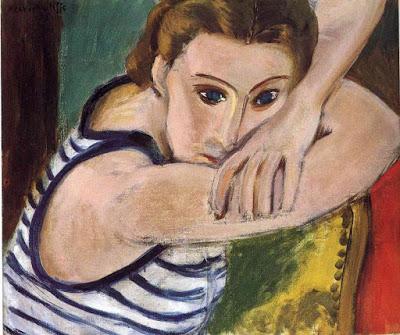
Blue Eyes by Henri Matisse
Q: I've been practicing yoga for decades and was recently thrown by a loop by a new diagnosis: glaucoma. When asked about yoga practice, the response I got was – “sure, it is fine.” I did just get my copy of your book and think your list of asanas to be avoided sounds prudent though it still makes me sad to let go of them. So - I'd like your thoughts on that.A: One of the many challenging changes of aging that we have mentioned previously on this blog is the gradual loss of our senses, including vision (see Aging Changes to the Brain and Nervous System). So this age-related specific condition should be of interest to many of our readers, who may teaching students who are suffering from or who may themselves be suffering from glaucoma.
Glaucoma is an eye condition in which the optic nerve is damaged, at least in part due to increasing pressures inside the eyeball. In the US, it is the leading cause of irreversible loss of vision. Although there are other factors that can contribute to glaucoma, rising intraocular pressure is the most common risk factor for glaucoma and the only modifiable factor that has been shown to slow down or prevent the progression of vision loss. In the US alone, there are approximately 2.7 million adults over the age of 40 with glaucoma, and this number is expected to rise to 4.1 million in the next 12 years. And it is the second leading cause of blindness internationally according to the WHO, just behind cataracts.
Glaucoma is typically treated with use of medicated eye drops that help to lower the pressure of the fluid inside the eye and by having the patient avoid physical activities that have been shown to increase the pressure inside the eyeball, such as push-ups and weight lifting.
Recently I read a 2015 collaborative study Intraocular Pressure Rise in Subjects with and without Glaucoma during Four Common Yoga Positions done on both normal adults and those with glaucoma by researchers in the US and Germany that demonstrated that certain inverted yoga poses, specifically Downward-Facing Dog pose (Adho Mukha Svanasana), Standing Forward Bend (Uttanasana), Legs up the Wall pose (Viparita Karani), and Plow pose (Halasana, increase the pressure inside the eye by 50-75% of baseline readings within 1-2 minutes of practicing the pose. The study also noted that the pressures returned to normal within 2 minutes after coming to a seated position. The researchers suggested that people with glaucoma may want to avoid these and possibly other inverted yoga poses as a precaution, even though there is no evidence to date that inverted yoga poses with holds of 1-2 minutes as observed in this study (longer holds were not addressed) contribute to the development of loss of vision or speed up that process.
And there are other factors that could impact glaucoma that have not yet been studied. For instance, we don’t yet know if doing dynamic poses that involve inverting, such as Dynamic Downward-Facing Dog pose or Standing Forward Bend, in which you are only in the inverted position for a second or so, cause a significant increase in intraocular pressure (IOP). If they do not, they could be wonderful ways to keep some inversions in your practice without risking injury to your eyes. We also do not know if holding demanding poses for longer periods of time, such as the Warrior poses, might also increase intraocular pressure the way pushups and weight lifting have been found to do. If so, shorter holds might be safer. So given what we still don’t know about yoga and glaucoma, I want to encourage the yoga research community to do follow-up studies along the above lines to help us get a better handle on what to recommend to those students with glaucoma to preserve their precious eyesight.
For now, I recommend that people with glaucoma should err on the side of caution. Along with avoiding the inverted poses, as we recommend in our book Yoga for Healthy Aging: A Guide to Lifelong Well-Being, I now also recommend avoiding partial inversions. Also, when you are practicing more physically demanding poses, those with glaucoma should do dynamic versions of the poses or, as we recommend for those with hypertension, practice shorter holds of 3-4 breaths.
While it is admittedly difficult to give up practicing poses you have enjoyed in the past, there is a huge cache of other poses and practices both in our book and on our blog that are very beneficial for your overall physical and emotional health, such as our stress management practices (see Chapter 8 of our book or Opening Your Yoga Toolbox) and our equanimity practices (see Chapter 9 of our book or Opening Your Yoga Toolbox). The equanimity practices could also be helpful for those dealing with the sense of loss and sadness when changing health requires a change in your yoga practice.
—Baxter
Subscribe to Yoga for Healthy Aging by Email ° Follow Yoga for Healthy Aging on Facebook and Twitter ° To order Yoga for Healthy Aging: A Guide to Lifelong Well-Being, go to Amazon, Shambhala, Indie Bound or your local bookstore.
Follow Baxter Bell, MD on YouTube, Facebook, and Instagram. For upcoming workshops and retreats see Baxter's Workshops and for info on Baxter see baxterbell.com.
